Caballero B. (ed.) Encyclopaedia of Food Science, Food Technology and Nutrition. Ten-Volume Set
Подождите немного. Документ загружается.


0004 Despite a great deal of individual variability in
the perception of these sensations, hunger can be
associated with clear symptoms; it is partly through
reference to these that people can make judgements
about the intensity of their hunger experience. The
measurement of hunger, desire to eat, or urge to eat is
most commonly conducted using fixed-point or
visual-analog scales. Respectively, these require the
subject to choose a number from a scale or a point
on a line that corresponds to their current state of
hunger. Careful presentation of these scales to people
who understand what is being asked of them will
yield meaningful information. More importantly,
quantifying the subjective experience of hunger
makes it a state, which is amenable to scientific inves-
tigation. Consequently, hunger can be described
qualitatively in terms of the sensations with which it
is associated, and it can also be measured quantita-
tively. This means that the significance of hunger can
be understood through its structure and by its inten-
sity. In recent years, the visual analog scale technique
has been incorporated into the screen of a small hand-
held computer. This device, called the Electronic
Appetite Rating System (EARS) provides a conveni-
ent and user-friendly way of monitoring hunger
during the course of a day.
Hunger, Eating Patterns and the Satiating
Power of Food
0005 If hunger is the feeling that reminds us to seek food,
then the consumption of food is the action that di-
minishes hunger and keeps it suppressed for a certain
period of time, perhaps until the next meal or snack.
The capacity of food to reduce the experience of
hunger is called the satiating power or satiating
efficiency. This power is achieved by certain proper-
ties of the food itself engaging with various physio-
logical and biochemical mechanisms within the body
that are concerned with the processing of food once it
has been ingested. The satiating power of food there-
fore results from a variety of biological processes and
is an important factor in the control of hunger. Some
foods have a greater capacity to maintain suppression
over hunger than other foods. (See Satiety and Appe-
tite: Food, Nutrition, and Appetite.)
0006 How is hunger related to the overall control of
human appetite and food consumption? The feeling
of hunger is an important component in determining
what we eat, how much we eat, and when we eat.
However, it must be seen in a context of social and
physiological variables. On the one hand, eating
patterns are maintained by certain enduring habits,
attitudes, and opinions about the value and suitability
of foods and overall liking for them. These factors,
derived from the cultural ethos, largely determine the
range of foods that will be consumed, and sometimes
the timing of consumption. The intensity of hunger
experienced may also be determined, in part, by the
culturally approved appropriateness of this feeling.
0007On the other hand, normal hunger is more import-
antly associated with the events surrounding meals –
so-called periprandial circumstances – and the
periods between meals. Thus, hunger can be con-
sidered to arise from an interaction between the
physiological requirements of the body for food
(or particular nutrients) and the capacity of food to
satisfy these requirements. Hunger will therefore be
successively stimulated and suppressed, giving rise to
a diurnal rhythm. This rhythm, and the relationship
between hunger and eating, may be modulated by
certain social factors (e.g., distressing psychological
events) or interrupted by some disease states.
Hunger and the Satiety Cascade
0008When food consumption reduces hunger and inhibits
further eating, two processes are involved. For tech-
nical precision and conceptual clarity, it is useful to
describe the distinction between satiation and satiety.
Both terms may be assigned workable operational
definitions (i.e., definitions that depend upon meas-
urable events). Satiation can be regarded as the pro-
cess that develops during the course of eating and
eventually brings a period of eating to an end.
Accordingly, satiation can be defined by the measured
size of the eating episode (volume or weight of food,
or value of the energy content). Hunger declines as
satiation develops and usually reaches its lowest point
at the end of a meal. Satiety is defined as the state of
inhibition over further eating that follows the end
of an eating episode and arises from the consequences
of food ingestion. The intensity of satiety can be
measured by the duration of time elapsing until eating
is recommenced, or by the amount consumed at the
next meal. The strength of satiety is also measured by
the duration of the suppression of hunger. As satiety
weakens, so hunger is restored. Figure 1 indicates the
changes that occur in the rating of hunger during a
meal (as satiation develops) and following a meal (as
satiety evolves). It can be seen that the measurement
of hunger is an important index of the degree of
satiation and satiety.
0009In the view of some researchers, satiation and
satiety can be referred to as intrameal satiety and
intermeal satiety, respectively. What mechanisms are
responsible for these processes? It is clear that the
mechanisms involved in reducing hunger and in
maintaining the suppression over hunger range from
those that occur when food is initially sensed, to the
HUNGER 3179
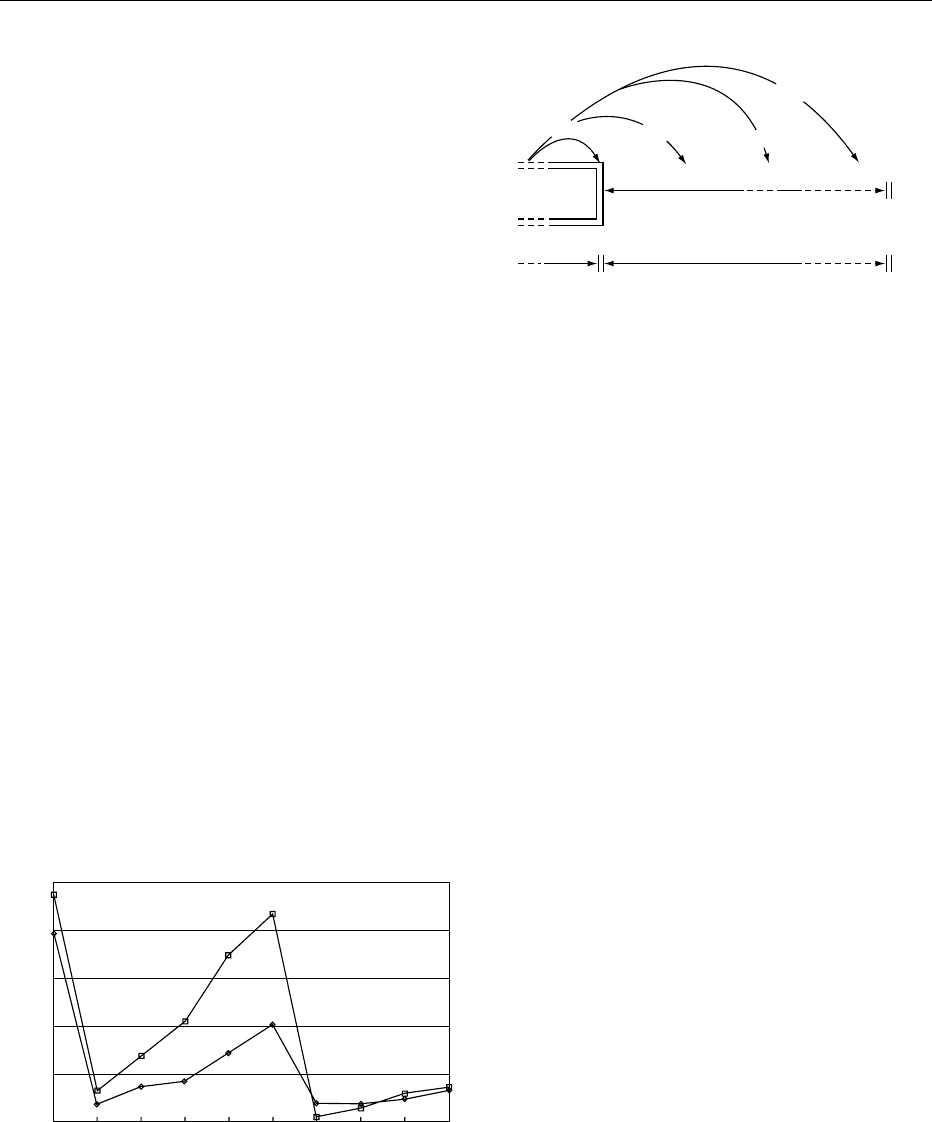
effects of metabolites on bodily tissues following
digestion and absorption (across the wall of the intes-
tine and into the bloodstream). By definition, satiety
is not an instantaneous event but occurs over a
considerable time period; it is therefore useful to dis-
tinguish different phases of satiety, which can be
associated with different mechanisms. This concept
is illustrated in Figure 2.
0010 Four mediating processes are identified: sensory,
cognitive, postingestive, and postabsorptive. These
maintain inhibition over hunger (and eating) during
the early and late phases of satiety. Sensory effects are
generated through the smell, taste, temperature, and
texture of food, and it is likely that these factors
inhibit eating in the very short term. Cognitive effects
represent the beliefs held about the properties of
foods, and these factors may help to inhibit hunger
in the short term. The category identified as post-
ingestive processes includes a number of possible
actions, including gastric distension and rate of gas-
tric emptying, the release of hormones such as chole-
cystokinin, and the stimulation of physicochemically
specific receptors along the gastrointestinal tract.
The postabsorptive phase of satiety includes those
mechanisms arising from the action of metabolites
after absorption across the intestine and into the
blood system. This category embraces the action of
chemicals such as glucose and amino acids, which
may act directly on the brain after crossing the
blood–brain barrier or may influence the brain
indirectly via neural inputs following stimulation
of peripheral chemoreceptors. The most important
suppression and subsequent control of hunger is
brought about by postingestive and postabsorptive
mediating processes.
Conditioned Hunger
0011It should be kept in mind that the psychobiological
system for appetite control has the capacity to
learn, i.e., to form associations between the sensory
and postabsorptive characteristics of foods. This
means that it will be useful to distinguish between
the unconditioned effects of foods, i.e., those in
which the natural biological consequences of food
processing in the gut are reflected in satiety, and the
conditioned effects that come into play owing to
the links developed between sensory aspects of
food – particularly those that are tasted – and later
metabolic effects generated by the same food. The
sensory characteristics (or cues) therefore come
to predict the impact that the food will later
exert. Consequently, these cues can suppress hunger
according to their relationship with subsequent
physiological events. However, the potency of this
mechanism depends upon the stability and reliability
of the relationship between tastes (sensory cures) and
physiological effects (metabolic consequences) of
food. When there is distortion or random variation
between sensory characteristics and nutritional prop-
erties, the conditioned control of hunger is weakened
or lost. Therefore, learned hunger will not be an
important factor when the food supply contains
many foods with identical tastes but differing meta-
bolic properties.
Is Hunger the Cause of Eating?
0012In searching for an answer to this question, we can
begin by considering whether hunger is a necessary or
a sufficient condition for eating to occur. Since hunger
may be present, but a person may volitionally prevent
123
Time of rating (h)
Mean rating of hunger (mm)
DinnerLunch
0
20
40
60
80
100
0.5 0.75 1
fig0001 Figure 1 Profiles of the ratings of the subjective experience in
two groups of subjects, one of which ate a large lunch (^) and the
other a lunch 50% smaller (h). Each meal suppressed hunger,
but the intensity of hunger recovered more rapidly following the
small meal. Four hours after the first meal, subjects were given
another meal to eat (dinner), and hunger was again suppressed.
Hunger ratings reflect the amount of food consumed and the
timing of meals.
Mediating processes
Postabsorptive
Postingestive
LateEarly
Cognitive
Sensory
Food
SatietySatiation
fig0002Figure 2 Satiety cascade. This diagram represents the medi-
ating processes, arising from food consumption, that influence
the feeling of hunger and determine the satiating efficiency of the
food.
3180 HUNGER

themselves from eating (e.g., someone undertaking a
fast for moral or political conviction), hunger is not a
sufficient condition. Occasions can also be imagined
where a person would eat, if food was particularly
tempting, where no hunger was being experienced.
0013 Therefore, it appears that hunger is neither a suffi-
cient nor a necessary condition for eating, i.e., the
relationship between hunger and eating is not based
on biological inevitability. However, under many
circumstances, there is a synchronous relationship
between the pattern of food intake and the rhythmic
oscillation of hunger. Moreover, the results of many
studies confirm the strong relationship between the
intensity of experienced hunger sensations and the
amount of food consumed. For example, when
hunger and eating have been monitored continually,
it has been reported that ‘the correlation using hunger
ratings and intake during the same hour of the day
was r ¼< 0.5 (P < 0.02). That is, hunger ratings at the
start of each hour were correlated with reported
intake in the hour following each hunger rating.’ In
addition, significant correlations have been found
between hunger ratings prior to a lunch and subse-
quent intake of fat, protein, and energy, indicating
that these measures of subjective hunger provide a
valid index of actual food intake. The correlations
found in almost all studies indicate that, in many
circumstances, the measured intensity of hunger reli-
ably predicts the amount of food that will be con-
sumed. This fact has led to the proposal that there is a
causal connection between hunger and the size of a
following meal. Table 1 shows measured correlations
between hunger, food intake, and related subjective
experiences.
0014 These observations provide the basis for a working
conceptualization. The correlations are sufficiently
strong and reliable to allow us to act as if hunger is
a cause of eating. In actuality, it is probably the case
that common physiological mechanisms induce
changes both in hunger and in the eating response.
Therefore, we can consider an appetite control system
in which hunger, eating, and physiological mechan-
isms (of the satiety cascade) are coupled together.
However, the coupling is not perfect, and there will
be circumstances where, for example, a physiological
treatment will change eating but not hunger. In other
words, uncoupling can occur. However, when this
happens, e.g., under certain conditions of fasting or
in disordered eating, the mechanisms responsible can
provide useful information about the role of hunger
in the overall control of appetite. It should be noted
that, although a number of individuals often deny
that sensations of hunger are related to when eating
occurs, under scientifically controlled conditions,
there is usually a strong relationship between hunger
and eating. (See Sensory Evaluation: Sensory Charac-
teristics of Human Foods.)
Disorders of Hunger
0015The clinical eating disorders, anorexia nervosa and
bulimia nervosa, are commonly believed to encom-
pass major disturbances of hunger. Yet the role that
hunger may play is not entirely clear. Contrary to the
literal meaning of the term, ‘anorexia’ is not experi-
enced as a loss of appetite. Rather, clinicians recog-
nize that anorexics may endure intense bouts of
hunger during their self-imposed restricted eating.
For some, their strength in resisting intense episodes
of hunger provides a feeling of self-mastery and con-
trol that is absent in most other areas of their lives.
Anorexics therefore overcome their feelings of
hunger. However, there is some evidence to suggest
that in conditions of total starvation, hunger may
become temporarily diminished. However, once
eating is recommenced, hunger may return rapidly
and with extreme intensity. (See Anorexia Nervosa.)
0016Like anorexia, bulimia finds its literal meaning in
an altered state of hunger –‘ox hunger.’ But again, the
term is imprecise. Close analysis of the physiological
states, which characteristically provide an eating
binge, show hunger to be lower than it is prior to a
normal meal. In addition, while the urge to eat may
be strong during a binge, the large amount of food
consumed implies some defect in satiation rather than
in hunger. Research that has monitored hunger in
eating disordered patients during a simple meal de-
scribes both great individual variability in the hunger
experience and examples of extreme disorganization.
In some cases, hunger appears quite dissociated from
the circumstance of eating. It is likely that a stable
tbl0001 Table 1 Intercorrelations between ratings of hunger, other
subjective sensations, and measure of food intake observed in
experimental studies in lean and obese subjects (all correlation
coefficients shown are statistically significant)
Food intake
(kcal)
Hunger Desire to
eat
Fullness
Lean subjects
Hunger 0.75
Desire to eat 0.77 0.96
Fullness 0.69 0.93 0.97
Prospective
consumption
0.80 0.97 0.95 0.91
Obese subjects
Hunger 0.65
Desire to eat 0.68 0.96
Fullness 0.54 0.75 0.77
Prospective
consumption
0.66 0.88 0.89 0.78
HUNGER 3181

eating pattern is necessary in order to normalize the
experience of hunger, and this may take a long time to
establish. (See Bulimia Nervosa.)
0017 Obesity is another condition in which hunger is
often assumed to be impaired. In seeking a cause for
excess weight, overeating has been regarded as being
caused by high levels of hunger. Although it is now
accepted that, on average, obese individuals have a
higher energy intake than lean people, this cannot
necessarily be assigned to higher levels of hunger. It
appears that the experience of hunger is similar in
lean and in most obese subjects. Studies suggest that
in general, there is no gross fault in the obese food-
intake regulation system. Any ‘fault’ is likely to be
subtle. An indication of this comes from the response
to a reduced-energy diet. Obese people, in common
with those of normal weight, respond to a reduction
in their energy intake by increased feelings of hunger.
Alternatively, anorectic drugs or nutrients that sup-
press hunger appear to do so similarly in obese and
lean people. Attempts to lose weight by dieting may
fail because of an inability to manage hunger. How-
ever, it should be recognized that for some very obese
people, the sensation of hunger occurs in an eccentric
fashion and is not related to periods of eating. Some
people can report strong feelings of hunger and full-
ness simultaneously, (See Obesity: Etiology and
Diagnosis.)
Hunger and Health
0018 The analysis of the phenomenon of hunger, the influ-
encing mechanisms, and its relationship to the regu-
lation of food intake indicate that hunger is a potent
factor in the maintenance of general health. In
societies where food is plentiful, the relatively mild
experiences of hunger play a biological useful role in
the orderly regulation of eating patterns. When food
is scarce, the power of hunger can drive people to
desperate deeds. In certain disease states, a very in-
tense hunger or its absence can indicate the severity of
the underlying pathology. In other extreme circum-
stances, hunger is forced out of synchrony with
physiological mechanisms, eating behavior, or both.
This labile or disregulated hunger reflects the path-
ology of the appetite system. The drive to eat, identi-
fied as hunger, is therefore a significant marker of
health. If the mechanisms underlying this drive are
compromised, hunger can become difficult to control.
(See Malnutrition: The Problem of Malnutrition.)
See also: Anorexia Nervosa; Bulimia Nervosa;
Malnutrition: The Problem of Malnutrition; Obesity:
Etiology and Diagnosis; Satiety and Appetite: Food,
Nutrition, and Appetite; Sensory Evaluation: Sensory
Characteristics of Human Foods
Further Reading
Blundell JE and Rogers PJ (1991) Hunger, hedonics, and the
control of satiation and satiety. In: Friedman M and
Kare M (eds) Chemical Senses, vol. 4, pp. 127–148.
New York: Marcel Dekker.
De Castro JM and Elmore DK (1988) Subjective hunger
relationships with meal patterns in the spontaneous
feeding behaviour of humans: evidence for a causal
connection. Physiology and Behaviour 43: 159–165.
Hill AJ, Magson LD and Blundell JE (1984) Hunger and
palatability: tracking ratings of subjective experience
before, during and after the consumption of preferred
and less preferred food. Appetite 5: 361–371.
Keys A, Brozek J, Henscher A, Mickelson O and Taylor HL
(1950) The Biology of Human Starvation, vol. II. Min-
neapolis, MN: University of Minnesota Press.
King NA, Lawton CL, Delargy HJ, Smith FC and Blundell
JE (1997) The electronic appetite rating system (EARS):
a portable computerised method for continuous auto-
mated monitoring of motivation to eat and mood. In:
Wellman PJ and Bartley GH (eds) Ingestive Behavior
Protocols, pp. 71–76. Society for the Study of Ingestive
Behavior.
Monello LF and Mayer J (1967) Hunger and satiety sensa-
tions in men, women, boys and girls. American Journal
of Clinical Nutrition 20: 253–261.
Hydrogenation See Vegetable Oils: Types and Properties; Oil Production and Processing; Composition
and Analysis; Dietary Importance
3182 HUNGER

Hygiene See Cleaning Procedures in the Factory: Types of Detergent; Types of Disinfectant; Overall
Approach; Modern Systems; Food Poisoning: Classification; Tracing Origins and Testing; Statistics; Economic
Implications; Contamination of Food; Escherichia coli: Occurrence; Detection; Food Poisoning; Occurrence and
Epidemiology of Species other than Escherichia coli; Food Poisoning by Species other than Escherichia coli;
Effluents from Food Processing: On-Site Processing of Waste; Microbiology of Treatment Processes; Disposal of
Waste Water; Composition and Analysis; Food Safety; Salmonella: Properties and Occurrence; Detection;
Salmonellosis; Saponins; Spoilage: Chemical and Enzymatic Spoilage; Bacterial Spoilage; Fungi in Food – An
Overview; Molds in Spoilage; Yeasts in Spoilage
Hyperglycemia (Hyperglycaemia) See Diabetes Mellitus: Etiology; Chemical Pathology;
Treatment and Management; Problems in Treatment; Secondary Complications
HYPERLIPIDEMIA (HYPERLIPIDAEMIA)
J P D Reckless and J M Lawrence, University of
Bath, Combe Park, Bath, UK
Copyright 2003, Elsevier Science Ltd. All Rights Reserved.
Lipids
0001 Lipids are a heterogeneous group of substances that
play key roles in normal physiology. Two groups are
important – that where a main component includes
one or more fatty acids (such as triglycerides and
phospholipids) and that where the main component
is a steroid nucleus (such as cholesterol and steroid
hormones). Both groups are relatively insoluble in
water. The lipoprotein transport system carries these
hydrophobic compounds through the aqueous
medium of blood plasma to their site of use, in a
carefully regulated process. Lipoproteins consist of a
package of triglycerides, cholesterol (free and esteri-
fied), phospholipids, and apolipoproteins, with a
hydrophilic shell and a hydrophobic core (Figure 1).
The sites of synthesis are the gut and liver. The main
lipoproteins are high (HDL), low (LDL), and very
low (VLDL) density lipoproteins, and chylomicron7s.
Each has a different group of surface apolipo-
proteins, pivotal in determining the site, mechanism,
and speed of lipoprotein metabolism. The precise
molecular composition in each lipoprotein class
varies considerably.
0002 Hyperlipidemia means high levels of fats in the
blood, which may be physiological postprandially.
Pathological hyperlipidemia results from disordered
metabolism of the lipoproteins with either excess
production, altered clearance, or both. It is most
commonly multifactorial, involving both environ-
mental and intrinsic factors. Many genetic disorders
are now well recognized, causing various degrees of
hyperlipidemia or dyslipidemia (altered compos-
ition). Genetic studies have helped the understanding
of lipoprotein metabolism.
0003This review discusses normal lipoprotein metab-
olism, focusing on hyperlipidemia. As treating
hyperlipidemia has significant benefits in terms of
long-term health, having an understanding of normal
and abnormal lipoprotein metabolism is becoming
increasingly important.
The Intestine
0004Most dietary fats are triglycerides. These are hydro-
lyzed to mono- and diacylglycerols, nonesterified
fatty acids (NEFA) and glycerol by pancreatic or gut
lipases, and absorbed as mixed micelles in the small
intestine. In the intestinal cells, triglycerides are
reformed and interact with apolipoprotein B-48
(apoB48) to form chylomicrons. ApoB48 is the struc-
tural protein for chylomicrons. Each chylomicron
has one molecule of apoB48 and carries very large
numbers of triglyceride molecules. Precise numbers
vary widely, as does the chylomicron size, depending
on the diet (diameter 100–1000 nm). Chylomicrons
also accommodate any dietary cholesterol absorbed
HYPERLIPIDEMIA (HYPERLIPIDAEMIA) 3183
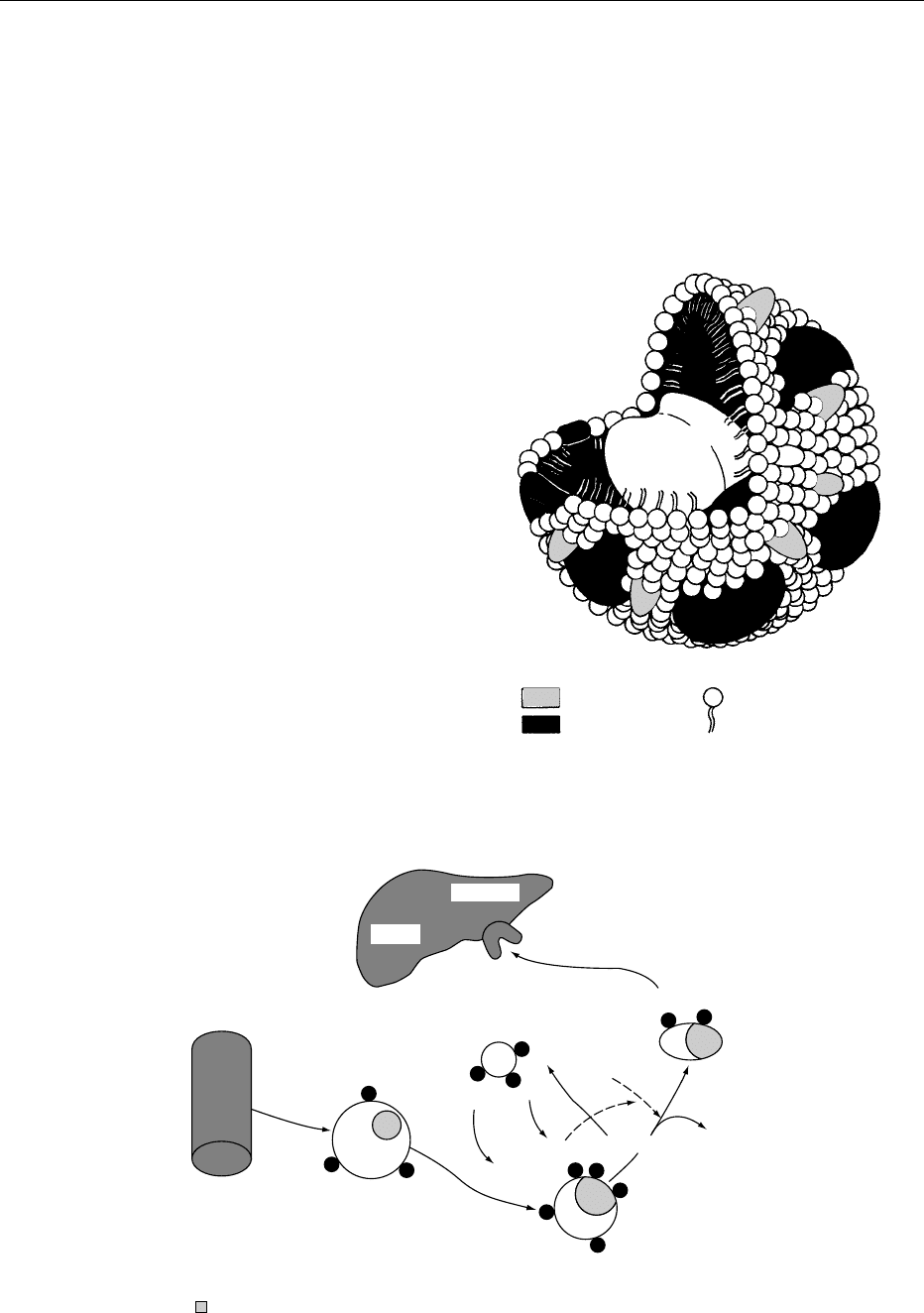
(usually less than 0.5 g per day). They are released
into the intestinal lymphatics and subsequently into
the circulation via the thoracic duct.
Chylomicron Metabolism
0005 In the systemic circulation, chylomicrons receive
apolipoproteins additional to apoB48, particularly
apolipoprotein C (apoC) and apolipoprotein E
(apoE), from HDL (Figure 2). One apoC, apoC-II,
activates the enzyme lipoprotein lipase (LPL) and
facilitates ligand/enzyme binding between LPL and
chylomicrons. LPL is found widely on capillary endo-
thelial tissues of many organs including adipose tissue
and skeletal and cardiac muscle. The activated
enzyme hydrolyzes chylomicron-triglyceride, and
NEFA are released for uptake into tissues to be stored
or used as energy. As triglyceride is removed, the
relative concentration of cholesterol rises, and the
lipoprotein becomes smaller and denser. Excess sur-
face components of phospholipids, free cholesterol,
and apolipoproteins (but not the apoB48) are trans-
ferred to HDL. The efficiency of this process depends
on the activity of LPL and also the VLDL triglyceride
level in the circulation, as VLDL competes with chy-
lomicrons for LPL. The chylomicron remnant is re-
moved by liver receptor uptake, dependent on
multiple copies of apoE on the remnant surface.
This receptor is structurally related to the LDL recep-
tor (see Low Density Lipoprotein) as a member of
the LDL-supergene family and is named the LDL
receptor-related protein (LRP). The affinity of the
binding depends on the apoE phenotype. Chylomicron
remnant removal effectively delivers dietary choles-
terol and residual triglyceride to the liver.
Very Low Density Lipoproteins (VLDL)
0006VLDL are the other major triglyceride-rich lipopro-
teins (Figure 3). They carry endogenous, hepatically
CE
TG
free cholesterol
apoprotein
phospholipid
fig0001Figure 1 Diagram of a human plasma lipoprotein. From Feher
and Richmond, Lipid and Lipid Disorders, Gower Medical Publish-
ing, with permission.
Receptor
LIVER
Cholesterol
Tg
SMALL INTESTINE
Chylomicron
Apo−AI
Apo−B48 C
E
AI
LPL
Apo−CIII
Apo−CII
Apo−AI
Apo−E
Apo−E
Apo−B48
Apo−B48
Chylomicron
remnant
FFA
+
Glycerol
HDL
2
fig0002 Figure 2 Chylomicron metabolism: synthesis and degradation. The pathway for metabolism of triglyceride of exogenous, dietary
origin. h, triglyceride (Tg);
, cholesterol; LPL, lipoprotein lipase; FFA, free fatty acid. Reproduced from Hyperlipidaemia, Encyclo-
paedia of Food Science, Food Technology and Nutrition, Macrae R, Robinson RK and Sadler MJ (eds), 1993, Academic Press.
3184 HYPERLIPIDEMIA (HYPERLIPIDAEMIA)
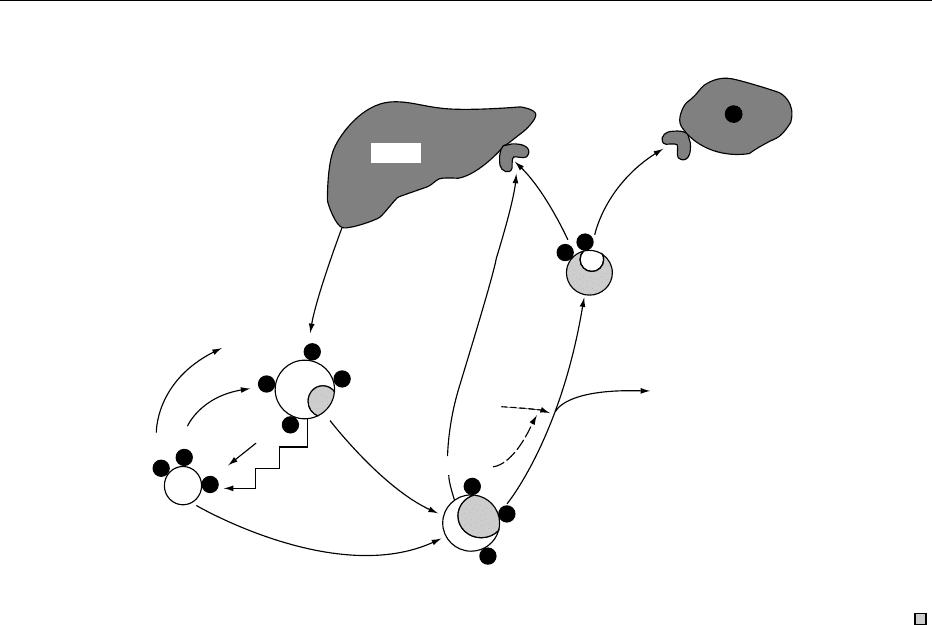
synthesized triglycerides, largely derived from dietary
carbohydrate or from plasma NEFA, and are of a
large size (30–60 nm diameter). Each VLDL particle
has a single molecule of a larger apoB form, apoB100,
with other apolipoproteins (apoE and apoCs) being
acquired in plasma from HDL. Like apoB48, apoB100
has a structural role, but also a functional role as a
ligand for catabolism. The same gene codes for apoB
in both gut and liver, but in the gut, there is post-
translational editing of messenger RNA, resulting in a
stop codon at position 2153. A truncated (48%)
apoB48 is then formed as the structural apolipopro-
tein, whereas in VLDL, the whole 100% of apoB is
synthesized to provide also the functional ligand
component.
0007 VLDL size is dependent on the triglyceride content,
with large buoyant triglyceride-enriched VLDL being
formed at times of triglyceride excess. These large
VLDL may be a poorer substrate for the usual path
of metabolism involving apoCII-dependent activation
of LPL and apoCII-LPL binding similar to that seen
with chylomicrons, and thus have a longer residency
time in the blood. As triglyceride is hydrolyzed,
VLDL particles shrink with loss of surface compon-
ents to HDL and subsequent catabolism to LDL via
IDL. This process is less efficient in the presence of
high triglyceride levels and large buoyant VLDL. A
longer plasma residency time allows a greater
exchange of triglyceride from VLDL into LDL and
HDL with reverse exchange of cholesterol ester,
mediated by cholesterol ester transfer protein
(CETP). This produces cholesterol-enriched VLDL
remnants that are less readily metabolized to LDL
and can be removed by alternative, but potentially
atherogenic, pathways. Additionally, this process
produces triglyceride-enriched LDL that shrink as
some triglyceride is hydrolyzed in the liver by another
endothelial enzyme, hepatic lipase, producing small,
dense LDL
3
(see below).
Intermediate Density Lipoproteins (IDL)
0008Intermediate density lipoproteins are formed as an
intermediate step in the normal metabolism of
VLDL. They are catabolized rapidly, and the concen-
tration in the plasma is therefore usually very low.
IDL are either taken up directly by the liver through
binding of surface apoE on IDL to apoE or apoB100/
apoE receptors, or are converted to LDL. The exact
mechanism of this is unclear but involves the loss of
Receptor
Receptor
LIVER
Apo−E
Apo−C
Apo−A
VLDL
Apo−B100
Apo−B100
E
C
A
Chol
CETP
HDL
2
*Chol
IDL
LDL
LPL
Apo−CII
Apo−E
Apo−E
Apo−B100
FFA
+
glycerol
EXTRAHEPATIC
TISSUES
fig0003 Figure 3 VLDL metabolism. The pathway for metabolism of triglyceride of endogenous, hepatic origin. h, triglyceride (Tg); ,
cholesterol; LPL, lipoprotein lipase; FFA, free fatty acid; Chol, free cholesterol; *Chol, esterified cholesterol; CETP, cholesterol ester
transfer protein. Reproduced from Hyperlipidaemia, Encyclopaedia of Food Science, Food Technology and Nutrition, Macrae R, Robinson
RK and Sadler MJ (eds), 1993, Academic Press.
HYPERLIPIDEMIA (HYPERLIPIDAEMIA) 3185
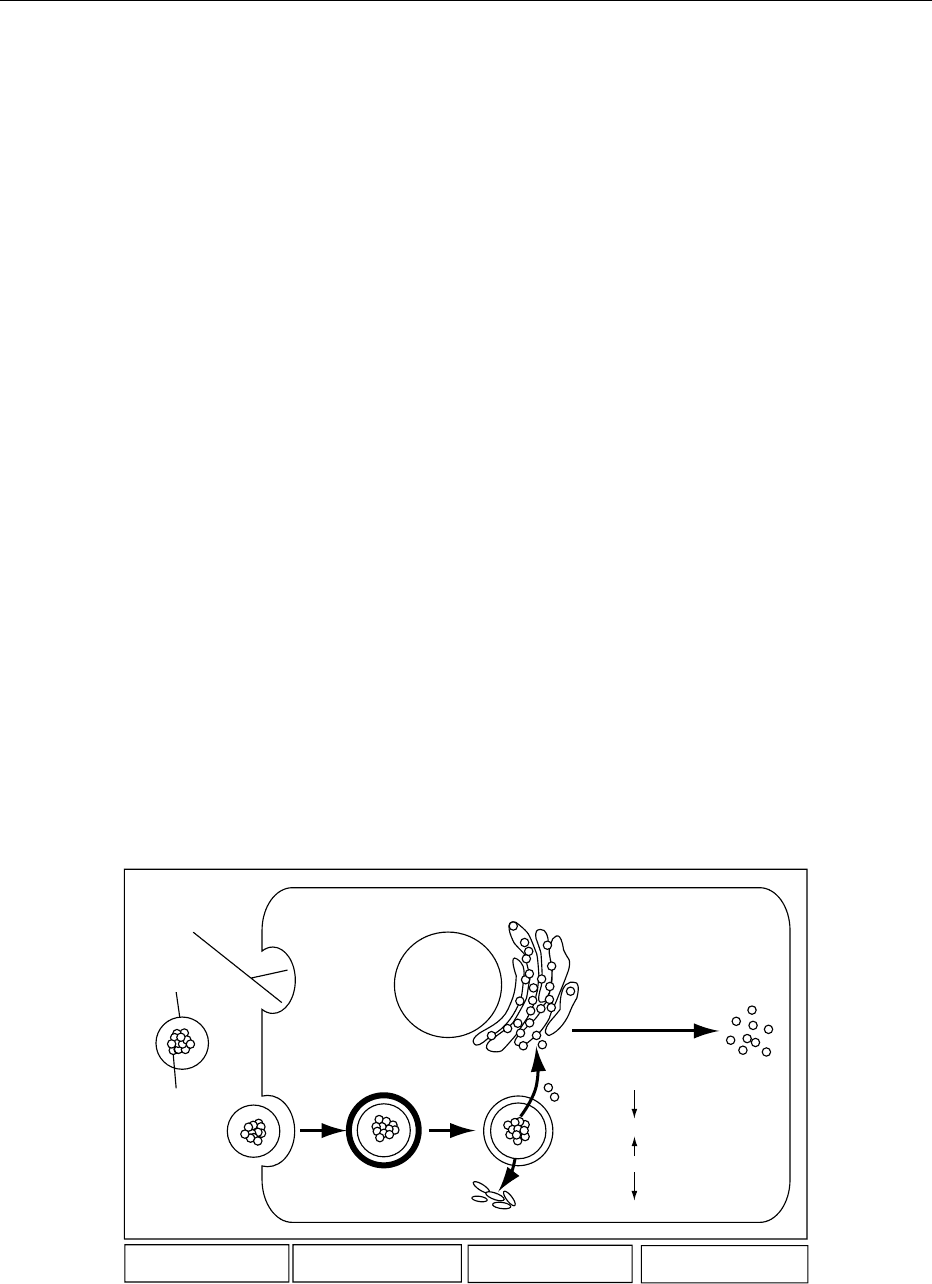
apoE and the C-apolipoproteins and further triglycer-
ide hydrolysis by hepatic lipase.
Low Density Lipoproteins (LDL)
0009 LDL are effectively responsible for delivery to tissues
of cholesterol used for cell membrane synthesis and
repair, and for processes such as synthesis of steroid
hormones and vitamin D (Figure 4). Entry into cells
occurs either in a concentration-dependent nonspeci-
fic manner or, more importantly, by a very closely
regulated receptor-mediated pathway. LDL bind to
specific LDL apoB100/apoE receptors on cell mem-
branes, and LDL–receptor complexes are internalized
and undergo lysosomal degradation. The cholesterol
ester is hydrolyzed to free cholesterol, while most of
the LDL receptors are recycled. The highest concen-
tration of receptors is found in the liver.
0010 In order to maintain cellular function, the cell con-
tent of cholesterol is very tightly regulated. High
intracellular levels of free cholesterol lead to:
1.
0011 Suppression of endogenous cell cholesterol synthe-
sis by inhibition of the rate limiting enzyme 3-
hydroxy, 3-methylglutaryl coenzyme-A reductase
(HMG CoA-reductase).
2.
0012 Suppression of apoB-100/apoE receptor synthesis.
3.
0013 Increased activity of acyl-coenzyme A cholesterol
acyl-transferase (ACAT), leading to increased
cholesterol esterification.
LDL particles are not homogeneous and can be
divided on the basis of size and density into LDL
1
,
LDL
2
, and LDL
3
. LDL
1
, the largest and least dense, is
a better substrate for the LDL receptor and is also less
easily oxidized. Individuals with higher levels of LDL
1
relative to LDL
3
are said to have a type A phenotype,
and those with the converse are said to have a type B
phenotype. Excess LDL
3
is associated with an excess
risk of coronary heart disease (see Hyperlipidemia
and the Origin of Clinical Atheroma below).
High Density Lipoproteins (HDL)
0014HDL are the smallest, most dense of the lipoproteins,
and are involved as cholesterol acceptors in reverse
cholesterol transport from the peripheral tissues to
the liver where the cholesterol is either excreted into
the bile or assembled into other lipoproteins
(Figure 5). HDL are synthesized in both the liver
and gut. Initially secreted as disk-shaped protein and
phospholipid bilayers, they mature by acquiring lipid
and protein components from intracellular and extra-
cellular fluids and from other lipoproteins to form
spherical particles of 5–15 nm diameter. The predom-
inant and structural apolipoproteins of HDL are
apolipoproteins A-I and A-II, with significant
amounts of apoCs and apoE, but with no apoB.
HDL particles are divided by size and density into
smaller and denser HDL
3
and larger and less dense
HDL
2
. HDL
2
particles tend to contain apo A-I only
and HDL
3
particles tend to contain both apoAI
and apoAII. The presence of larger, less dense HDL
2
correlates with more efficient reverse cholesterol
transport.
LDL
receptors
Protein
LDL
Cholesteryl
linoleate
LDL binding Internalization
Lysosomal
hydrolysis
Regulatory actions
1
2
3
Golgi apparatus
Cholesteryl
oleate
HMG CoA
reductase
ACAT
LDL receptors
1
2
3
Amino acids
fig0004 Figure 4 Regulation of intracellular cholesterol concentration by LDL-cholesterol uptake. Reproduced from Hyperlipidaemia, En-
cyclopaedia of Food Science, Food Technology and Nutrition, Macrae R, Robinson RK and Sadler MJ (eds), 1993, Academic Press.
3186 HYPERLIPIDEMIA (HYPERLIPIDAEMIA)
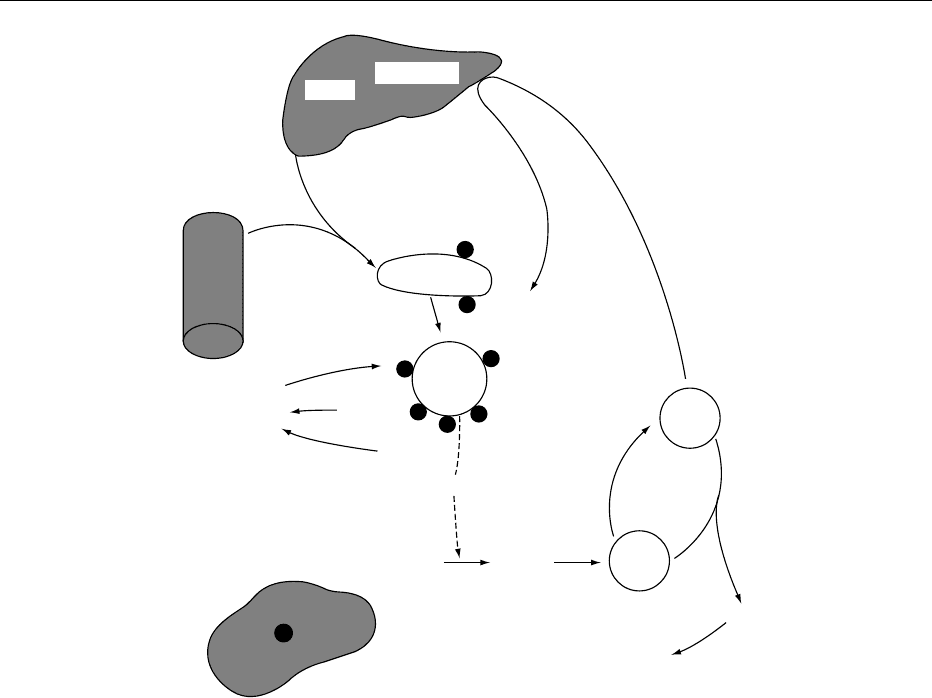
0015 The mechanism of reverse cholesterol transport is
gradually being elucidated. Evidence suggests that
cells replete with cholesterol express HDL-binding
sites on the plasma membrane. Intracellular signaling
promotes hydrolysis of stored cholesterol esters,
movement of free cholesterol to the cell surface, and
transfer down a concentration gradient to HDL. Sur-
face cholesterol is esterified by lecithin cholesterol
acyl transferase (LCAT), an HDL-associated enzyme.
The resulting hydrophobic cholesterol ester enters the
HDL core, leaving the surface cholesterol depleted
and thus maintaining the concentration gradient
with the cell membrane. Cholesterol esters are trans-
ferred from HDL by CETP to VLDL, IDL, and LDL.
Cholesterol esters are delivered to the liver substan-
tially by receptor-mediated LDL uptake, and some
directly delivered from HDL. Synthesis of HDL
depends on transfer of surface components from
VLDL catabolism. When there is hypertriglycerid-
emia, the number and size of VLDL particles rise.
As larger VLDL particles tend to be catabolized
more slowly, the availability of surface components
for HDL is reduced, hence partly explaining the fre-
quent inverse relationship between the concentra-
tions of VLDL and HDL.
Consequences of Hyperlipidemia
0016While severe hypertriglyceridemia can lead to pan-
creatitis, the major consequence of hyperlipidemia is
accelerated atherogenesis with premature coronary
heart disease (CHD), stroke, and peripheral vascular
disease. The major risk factors for early CHD are
hypertension, cigarette smoking, hyperlipidemia,
and diabetes mellitus, risk increasing markedly when
multiple risk factors are present.
Hyperlipidemia and the Origins of Clinical
Atheroma
0017Atheroma occurs in large elastic and muscular arter-
ies such as the aorta, coronary, femoral, and carotid
LIVER
Cholesterol
SMALL INTESTINE
Apo−AI
Apo−AI
Apo−AII
Apo−AII
Apo−E
Apo−C Apo−D
LCAT
LCAT
CETP
*Chol
Chol
HDL
2
HDL
3
Cholesterol
CHOLESTEROL RICH
CELLs
VLDL
+
chylomicron
VLDL
fig0005 Figure 5 HDL metabolism; Chol, free cholesterol; *Chol, esterified cholesterol; CETP, cholesterol ester transfer protein; LCAT,
lecithin cholesterol acyl transferase. Reproduced from Hyperlipidaemia, Encyclopaedia of Food Science, Food Technology and Nutrition,
Macrae R, Robinson RK and Sadler MJ (eds), 1993, Academic Press.
HYPERLIPIDEMIA (HYPERLIPIDAEMIA) 3187

arteries, and especially at predisposed sites such as
bifurcations where there is flow disturbance. Plaques
form on the basis of fatty streaks that may be present
very early in life. Damage to the endothelial lining
from high blood pressure, local injury, or poor
oxygen supply results in increased permeability,
enabling lipoproteins to pass more easily into the
subendothelial space. LDL and triglyceride-rich lipo-
protein remnants are atherogenic. The influx into the
arterial wall depends on both the concentration and
the size of the LDL particles in plasma. The higher the
concentration of LDL in the plasma, the greater is the
degree of influx, and smaller denser LDL
3
particles
cross the endothelium more easily. LDL in the arterial
wall undergoes a number of changes including oxida-
tion with LDL
3
particles being more susceptible. The
oxidized LDL particles are engulfed by scavenger
macrophages. These macrophages are formed from
monocytes that have traversed the damaged endothe-
lial wall and are immobilized in response to a number
of chemical signals. In response to altered LDL, the
macrophages express acetylated LDL receptors and
take up LDL to become lipid rich foam cells. These
undergo apoptosis producing a lipid-rich extracellu-
lar medium. Smooth muscle cells migrate from the
arterial media in response to this process. These pro-
liferate and produce a connective tissue matrix rich
in collagen, elastin, and proteoglycans forming the
plaque cap, as part of a damage-healing process.
0018 Plaques may be asymptomatic. In contrast, they
may result in a significant reduction in blood flow,
producing symptoms such as angina or claudication.
A plaque that has a thin cap and a large lipid core
may be unstable and susceptible to rupture. In
such plaques, the excess macrophage component
produces metalloproteinases that break down the
collagen matrix (synthesized by smooth muscle
cells), making cap thinning and plaque rupture
(especially at the shoulder of the cap) more likely.
Should this happen, acute occlusion of a vessel may
occur, causing syndromes such as acute myocardial
infarction.
Classification of Hyperlipidemia
0019 Hyperlipidemia normally refers to high concentra-
tions of the blood lipids, cholesterol, and triglycer-
ides. These high levels reflect underlying changes in
lipoproteins, and could be caused by overproduction,
reduced catabolism or both. Thus, high levels of
triglycerides reflect elevated concentrations of the
triglyceride-rich lipoproteins, chylomicrons and
VLDL, and their remnants. An increase in cholesterol
concentration usually reflects an increase in LDL,
with or without an accompanying increase in VLDL.
Occasionally, raised total cholesterol may be due to a
very high HDL alone.
0020Hyperlipidemia may be secondary to other medical
disorders or therapy, or it may be primary. Primary
hyperlipidemia may be caused by a single gene defect
or, more commonly, by a polygenic background
influenced by environmental factors.
0021Originally, primary (inherited) disorders were
classified on the physicochemical characteristics of
lipoproteins defined in the laboratory using ultracen-
trifugation or electrophoresis (Table 1). Treatment of
a patient’s hyperlipidemia often results in changes in
the lipoprotein pattern and laboratory characteristics,
so that such a classification has limited value. It is
more useful to define the disease or metabolic defect,
and as this is becoming increasingly possible, efforts
to do this should always be made. Secondary causes
of hyperlipidemia are listed in Table 2. Obesity,
diabetes, and excess alcohol commonly act on a
genetic background to produce hyperlipidemia.
Hypercholesterolemia
Common or Polygenic Hypercholesterolemia
0022In the population as a whole, cholesterol levels
approach a normal distribution. Epidemiological
tbl0001Table 1 Classification of hyperlipidemia (Fredrickson’s
classification, as modified by the World Health Organization)
Ty p e o f
hyperlipidemia
Cholesterol Triglyceride Lipoprotein raised
I Raised Chylomicrons
IIa Raised Normal LDL
IIb Raised Raised LDL plus VLDL
III Raised Raised IDL
IV Normal or
raised
Raised VLDL
V Raised Markedly
raised
Chylomicrons plus
VLDL
tbl0002Table 2 Commoner secondary causes of hyperlipidemia
Cause Example
Metabolic and nutritional Obesity
Alcohol
Endocrine Diabetes mellitus
Hypothyroidism
Pregnancy
Drugs b-blockers
Thiazides
Estrogens
Renal disease Chronic renal failure
Nephrotic syndrome
Liver disease Biliary obstruction
3188 HYPERLIPIDEMIA (HYPERLIPIDAEMIA)
